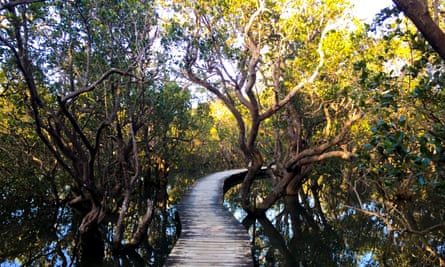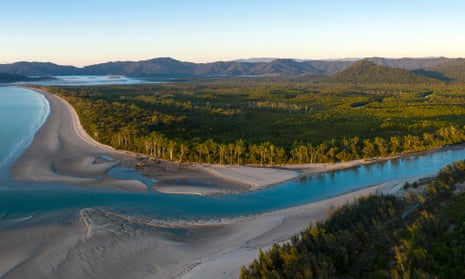Eastern Kuku Yalanji people will take formal ownership of the world heritage-listed Daintree tropical rainforest in northern Australia, after the Indigenous traditional owners reached a historic deal with the Queensland government.
The Daintree national park is part of 160,108 hectares (395,467 acres) of land that will be handed back to the traditional owners at a ceremony on Wednesday at Bloomfield, north of Wujal Wujal.
The handback will see the world’s oldest tropical rainforest join Australian landmarks such as Uluru and Kakadu, where First Nations peoples are the custodians of Unesco world heritage-listed sites.
Under the agreement to be signed on Wednesday, the Daintree, Ngalba Bulal, Kalkajaka and Hope Islands national parks will be handed back to the Eastern Kuku Yalanji. They will also manage the areas in partnership with the Queensland government.
“It’s a big thing for Eastern Kuku Yalanji people, for us bama, which means people,” said Chrissy Grant, a traditional owner and the incoming chair of the Wet Tropics Management Authority board.
“Bama across the wet tropics have consistently lived within the rainforest. That in itself is something that is pretty unique to the world heritage listing.
“It’s an opportunity to work our way up ... we will be looking at long-term gains out of this, but we need to work our way up to get our people trained up confident.”
Grant, who is also the chair of the Unesco International Indigenous People’s Forum for World Heritage, said the handback of the Daintree and surrounds would also help address a historical oversight, which meant rainforest Aboriginal people were not involved in the 1988 process for the world heritage listing of Queensland’s wet tropics.
At the time, the Daintree rainforest had come under increasing threat from logging and other development being pushed by the entrenched National party government in Queensland.
The Australian government, led by Bob Hawke, successfully campaigned for the Unesco listing in 1988, despite fierce opposition from the Queensland state government.
The Unesco listing recognises the environmental value and the “exceptional natural beauty” of the world’s oldest continually-surviving tropical rainforest, but not the Indigenous cultural values that are part of the formal Unesco listings at places like Uluru and Kakadu.
“In 1988 there was no consultation with Aboriginal people and no recognition of the values of the ... oldest rainforest in the world, being continuously occupied by Aboriginal people,” Grant said.
“Wherever you go there are communities within the tropical rainforest.
“People were probably not upset about it back at that time, but certainly after that time people realised they were completely ignored, even what was world heritage, not a lot of awareness out there. They did it in a rush to try to stop forest logging, but in that process they completely ignored Aboriginal people.”

The Australian government has since recognised the cultural value of the Daintree and the wet tropics, but the Unesco listing remains related to the environmental significance only.
Grant said the national parks would eventually be managed solely by traditional owners.
“Our goal is to establish a foundation to provide ... pathways and opportunities for mentoring, training, apprenticeships, work experience and employment for our Eastern Kuku Yalanji bama to fill positions from a wide range of skilled trades, land and sea management, hospitality, tourism, and research so that we are in control of our own destinies.”
The handback negotiations had taken four years and Grant said she hoped the model would offer a pathway for other Indigenous groups in other parts of the wet tropics to negotiate ownership of their traditional lands.
Quick GuideHow to get the latest news from Guardian Australia
Show

Email: sign up for our daily morning and afternoon email newsletters
App: download our free app and never miss the biggest stories
Social: follow us on YouTube, TikTok, Instagram, Facebook or Twitter
Podcast: listen to our daily episodes on Apple Podcasts, Spotify or search "Full Story" in your favourite app
The Queensland environment minister, Meaghan Scanlon, said the government had now returned 3.8m hectares (9.4m acres) of land at Cape York to traditional owners.
“The Eastern Kuku Yalanji people’s culture is one of the world’s oldest living cultures and this agreement recognises their right to own and manage their country, to protect their culture and to share it with visitors as they become leaders in the tourism industry,” Scanlon said.
“These national parks will protect important Aboriginal cultural sites, diverse ecosystems including rainforests, woodlands, wetlands and mangroves, and form part of the Wet Tropics world heritage area which is recognised as the second-most irreplaceable world heritage site on earth.”
The Queensland Aboriginal and Torres Strait Islander partnerships minister, Craig Crawford, said the handback showed the government was “committed to reconciliation, Treaty and righting the wrongs of past generations”.
“Some of the benefits for the traditional owners will be funds provided annually and in perpetuity for the joint management of the national parks,” he said.
Conservation groups also welcomed the agreement.
Andrew Picone, the protected areas campaign manager for the Queensland Conservation Council, said returning the parks to the Eastern Kuku Yalanji was “the best way to protect the area’s natural and cultural values”.
